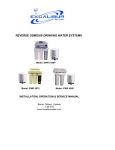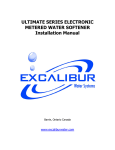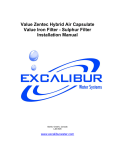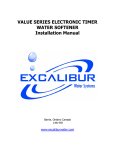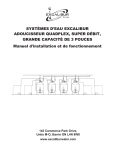Download Excalibur Water Systems EWR 5075 Service manual
Transcript
REVERSE OSMOSIS DRINKING WATER SYSTEMS Model: EWR 5075 INSTALLATION, OPERATION & SERVICE MANUAL Barrie, Ontario Canada www.excaliburwater.com TABLE OF CONTENTS Page INTRODUCTION TO THE REVERSE OSMOSIS DRINKING WATER SYSTEM . 1 PREPARATION A. Major System Components for the Reverse Osmosis Drinking Water System Installation Drawings for the Reverse Osmosis Drinking Water Systems B. Tools Recommended for Reverse Osmosis Drinking Water Installation C. Site Selection For Reverse Osmosis Major System Components 2 3 4 4 REVERSE OSMOSIS INSTALLATION STEPS A. Reverse Osmosis Faucet Installation Reverse Osmosis Faucet Drawing B. Reverse Osmosis Feed Water Ball Valve Installation C. Reverse Osmosis Drain Clamp Installation D. Position the Reverse Osmosis Drinking Water Holding Tank and Make the Final Hose Connections E. Reverse Osmosis Start Up 5 6 7 8 8 8 REVERSE OSMOSIS OPERATION AND MAINTENANCE A. Reverse Osmosis Normal Operation B. Reverse Osmosis Changing Filters C. Reverse Osmosis Changing the In-Line Activated Carbon Post Filter 9 10 10 TECHNICAL DATA A. Reverse Osmosis Water Quality REVERSE OSMOSIS TROUBLESHOOTING GUIDE 10 11/12 CAUTION: The Centers for Disease Control and Prevention (CDC) and the Environmental Protection Agency (EPA) have issued guidance to people with severely weakened immune systems who may want to take extra precautions to reduce the risk of infection with Cryptosporidium from drinking water. This guidance pertains to people with HIV/AIDS, patients receiving treatment for cancer, recipients of organ or bone marrow transplants, transplant patients taking immunosuppressive drugs, and persons who have congenital immunodeficiencies. The EPA has stated that they do not know the importance of drinking water compared to other possible sources of Cryptosporidium to determine how most people become infected. The CDC-EPA guidance suggest that immunosuppressed individuals discuss their risks with their health care provider. All individuals should take adequate precaution when changing the filter cartridges, including wearing protective gloves, to avoid direct contact with the exhausted cartridges. *For complete specifications, refer to the Performance Data Sheet. INTRODUCTION Your new Reverse Osmosis Drinking Water System uses a combination of filtration technologies to reduce unwanted contaminants in your water supply. Your Reverse Osmosis System uses the following steps combine to give you the best in clear sparkling Reverse Osmosis water: The Reverse Osmosis membrane is a specially constructed, fully aromatic polyamide film, and is classified as a Thin Film Composite (T.F.C.). The spiral wound construction of the Reverse Osmosis Membrane provides maximum surface area for water production and is less susceptible to fouling by particulate matter, turbidity and colloidal materials. REVERSE OSMOSIS MECHANICAL FILTRATION - The Reverse Osmosis Turbidity Pre-filter will remove suspended matter that are larger than 5 micron as well as silt, dirt, scale and rust. The 5 Micron nominal rating helps give maximum life to the Reverse Osmosis Membranes. REVERSE OSMOSIS IN-LINE ACTIVATED CARBON COCONUT SHELL POST FILTER – The Reverse Osmosis In-Line Activated Carbon Post Filter is located after the Holding Tank and reduces tastes and odours that may pass through the Reverse Osmosis system. It adds a final polish to the water. REVERSE OSMOSIS CARBON BLOCKS – The Reverse Osmosis Carbon Block Pre-filters contains carbon with a vast network of pores. The tremendous surface area of these pores (typically 800-1200 square meters per gram of carbon) gives the Reverse Osmosis carbon very good adsorption sites for substances that contribute to tastes and odours. The Reverse Osmosis carbon block in the Pre-filters will remove chlorine that may be present in the feed water. This Reverse Osmosis pretreatment is necessary for membrane protection. REVERSE OSMOSIS AUTOMATIC SHUTOFF VALVE – The Reverse Osmosis ASO Valve senses when the product water tank is full and closes the feed water supply to prevent excess Reverse Osmosis reject water from going to drain when the Reverse Osmosis System is not producing water. Premium models with booster pump utilize solenoid valves as the ASO auto shut off. REVERSE OSMOSIS FAUCET – The reverse osmosis faucet is a designer brushed nickel high flow 3/8” design goose neck with ceramic disc valve. REVERSE OSMOSIS MEMBRANE – The Reverse Osmosis Membrane is the heart of the Reverse Osmosis filtration system. The Reverse Osmosis system is designed to reduce the dissolved mineral content of the water. Minerals picked up in the environment by the water are measured as Total Dissolved Solids (TDS). In the Reverse Osmosis process, dissolved minerals are separated from the incoming water (the Permeate). The Reverse Osmosis excess minerals are rinsed to drain (the Reject Water). REVERSE OSMOSIS HOLDING TANK – The reverse osmosis faucet holding tank is 3.2 gallon plastic designed for the storage and repressurization of reverse osmosis pure drinking water with valve. 1 REVERSE OSMOSIS PREPARATION A. Reverse Osmosis Components The following components comprise the Reverse Osmosis Drinking Water System. (Refer to Fig. 1, below for general system layout.) 9. Reverse Osmosis Sediment Pre-filter, shrink wrapped. 10.Reverse Osmosis activated Carbon Prefilter, shrink wrapped. 11.Reverse Osmosis In-Line Activated Coconut Shell Carbon Post Filter. 12.Other items necessary for Reverse Osmosis installation may include wood screws or machine screws and nuts for mounting the manifold, or concrete anchors for hanging on basement wall. Additional Reverse Osmosis tubing or tube connectors. Reverse Osmosis Plastic wire ties for organizing tubing. 1. Reverse Osmosis Manifold assembly 2. Filter Housings with O-Rings 3. Water Storage Holding Tank 4. Designer Water Dispensing Faucet 5. Self Piercing Feed Water Saddle Valve 6. Reverse Osmosis Drain Clamp. 7. Installation tubing and connections 13. Reverse Osmosis Installation Kit 8. Membrane in sealed bag BALL 2 BALL 3 B. Tools Recommended for Reverse Osmosis Installation C. Site Selection for Major System Reverse Osmosis Components The following tools will cover most of the Reverse Osmosis installation sites encountered: The Reverse Osmosis System was designed to fit under a sink, however, because of space limitations or other reasons, the Reverse Osmosis system's flexible design allows for other locations. When determining the location of your Reverse Osmosis system remember that access to a cold water tap line, the household drain, and ease of Reverse Osmosis filter replacement are important considerations. 1. 3/8" variable speed electric drill. 2. Extension work light with outlet. 3. Safety glasses. 4. 5/8" Drill Bit and 1/8" and ½"metal drill bits for pilot hole. All Reverse Osmosis components and tubing should be located in an area not exposed to freezing temperatures. If winter temperatures are sever, the area should be above the minimum temperature listed in Table B, page 2 for proper performance. Do not expose Reverse Osmosis system or tubing to direct sunlight. 1. Reverse Osmosis Drinking Faucet – The Reverse Osmosis faucet should be placed near the sink where drinking water is normally obtained. Convenience of use (filling of water pitchers and glasses), and an open area beneath the Reverse Osmosis faucet under the sink for attaching product and Reverse Osmosis drain tubing are considerations. A 2" diameter flat surface is required above and below the Reverse Osmosis installation site. 6. Center punch and hammer. 7. Wood bits. 8. Concrete drill bits. 9. Assorted wood and metal drill bits including 7/32" metal drill bit. 10. Phillips head and flat blade screwdrivers. 11. ½", 9/16" and 5/8" open end wrenches. 12. 10" Crescent wrench with jaws taped to hold faucet. 13. Basin wrench or 10" pipe wrench. 14. Teflon tape. 15. Wide masking tape or duct tape. 16. Plastic tubing cutter. 2. Reverse Osmosis Holding Tank – The Reverse Osmosis Holding Tank may be placed where it is convenient within 10 feet of the Reverse Osmosis faucet; under the sink, in an adjacent cabinet are the best choices or in a basement within 20 feet of the Reverse Osmosis faucet. If a longer run of Reverse Osmosis tubing is required, a transfer delivery pump may be required extra to boost line pressure. 17. Extra plastic tubing. 18. Low range air pressure gauge. 19. Small bottle of liquid chlorine bleach. 20. Paper towels, wisk broom and assorted clean up materials. 3. Reverse Osmosis Manifold Assembly – The Reverse Osmosis manifold can be installed on either the right or left side of the under-sink area or a cabinet. The right side is recommended because all the Reverse Osmosis tubing will be to the back of the cabinet and out of the way. Reverse Osmosis Installation in the basement is also an option; one location is near the laundry/utility sink where cold potable water and rain access are handy. The mounting location should allow adequate clearance and accessibility for Reverse Osmosis cartridge changes. 4 4. Reverse Osmosis Feed Water Connection – The Reverse Osmosis Feed Water Saddle Valve should be located as close to the manifold assembly as possible. USE A POTABLE COLD WATER SUPPLY ONLY TO YOUR REVERSE OSMOSIS SYSTEM. Softened water is preferred as it will extend the life of the Reverse Osmosis Membrane. 2b. Drilling a porcelain sink: It is best to use a special 5/8" diameter cutter designed for porcelain. A carbide tipped masonry bit is a second choice. Place a piece of tape over the area to be drilled to help prevent chipping. Drill a pilot hole for the porcelain cutter. Use the pilot drill supplied with the kit or a carbide tipped drill. When drilling the 5/8" hole, drill slowly and carefully; the porcelain chips easily. After drilling, clean the area well. Iron fillings, if left in place, can cause rust stains. 5. Reverse Osmosis Drain Connection – The Reverse Osmosis waste water must go to a drain connection with easy access. Do NOT connect the Reverse Osmosis system drain line to the dishwasher drain or near the garbage disposal. REVERSE OSMOSIS INSTALLATION STEPS All plumbing should be done in accordance with local plumbing codes. 2c. Drilling a counter top: NOTE: The counter top must be less than 2¼" thick. Treat ceramic tiles as porcelain until the tile is penetrated, then use the carbide tipped metal cutter. In restricted under-sink areas, it may be easier to install the Reverse Osmosis faucet first. Allow adequate Reverse Osmosis tubing lengths for any final Reverse Osmosis component position. Formica counter tops may be drilled with a good 5/8" wood bit, drilling a 3/32" pilot hole will help keep the bit going straight. A. Reverse Osmosis Faucet Installation 2a. Drilling a stainless steel sink: Center punch the hole to provide a starting point for the drill. Start with a smaller drill as a pilot, and then drill a 5/8" diameter hole to accept the faucet to go through the countertop. Clean away any chips. Deburr any sharp edges. IMPORTANT NOTICES: This Reverse Osmosis system contains replaceable treatment components critical for effective performance. It is the user's responsibility to, and the manufacturer strongly recommends that the user periodically test the Reverse Osmosis product water to verify the Reverse Osmosis system is performing satisfactorily. The Reverse Osmosis system is acceptable for water treatment of influent concentrations of no more that 27 mg/l nitrate and 3 mg/l nitrate in combination measured as N and is certified for nitrate/nitrite reduction only for water supplies with a pressure of 40 psig (280 kPa) or greater. DO NOT USE WITH WATER THAT IS MICROBIOLOGICALLY UNSAFE OR OF UNKNOWN QUALITY, WITHOUT ADEQUATE DISINFECTION BEFORE OR AFTER THE SYSTEM. Reverse Osmosis Systems certified for cyst reduction may be used on disinfected water that may contain filterable cysts. 5 B. Reverse Osmosis Feed Water Ball Valve Installation 3. With the Reverse Osmosis Feed Water Ball Valve closed, open the Reverse Osmosis sink faucet and the water supply and allow the water to run for a few minutes to flush any debris caused by the installation. Decide on location. Do NOT connect Reverse Osmosis to a hot water feed line. Water over 100ºF may cause permanent damage to the Reverse Osmosis Membrane. (Refer to Fig. 3 page 8.) 1. Shut off the water supply and drain the line from the Reverse Osmosis system. 2. To install the Reverse Osmosis Feed Water Ball Valve: Attach the self piercing saddle valve to pipe and secure and tighten. Remove nut from the Reverse Osmosis feed water ball valve. Slide the nut onto the ¼” reverse osmosis tubing. Insert the ferrule and tube insert onto ¼” tubing Place the ¼” tubing onto the exposed threads of the Reverse Osmosis feed self piercing saddle valve. Screw the nut onto the Reverse Osmosis feed water ball valve. Close the Reverse Osmosis faucet and check the Reverse Osmosis Feed Water Saddle Valve for leaks. Once installation of Reverse Osmosis System is completed open Revere Osmosis feed saddle valve to allow flow of water. REVERSE OSMOSIS SELF PIERCING ¼” FEED WATER SADDLE VALVE 6 C. Reverse Osmosis Drain Clamp Installation 3. Locate the 3/8" Drain Tubing connected to the Reverse Osmosis System. Route to the Reverse Osmosis tubing to the Drain Clamp and trim to length. Choose the Reverse Osmosis drain outlet location. The following are instructions for discharging in the sink drain pipe. (Refer to Fig. 1, page 3) CAUTION: The lowest point of the line should be the point of connection to the Reverse Osmosis Drain Clamp. There should be no sag in the Reverse Osmosis tubing as this may cause excessive noise as the reject water is flowing to drain. 1. Position the Drain Clamp on the sink drain pipe above the drain trap. Allow room for drilling. Tighten securely. 2. Use a battery powered or properly grounded drill. Using the Clamp port as a drill guide, drill a 7/32" hole through the wall of the drain pipe. Refer to Fig. 4, below. To connect the Drain Tubing, install the Compression Nut and the Brass Insert. Insert the tubing into the Drain Clamp and tighten the Compression Nut. Figure 4 7 Slowly open the Reverse Osmosis Feed Water Saddle Valve (turning counter clockwise). D. Position the Reverse Osmosis Holding Tank & Make the Final Hose Connections 1. Check the Reverse Osmosis tank precharge pressure. Make sure it is between 5 to 7 psig. As soon as the water begins to come out of the Reverse Osmosis Dispensing Faucet, close the Faucet. 2. Pull the cap/plug off the top of the Reverse Osmosis tank where the Reverse Osmosis Tank Shut-Off should go. (Refer to Fig. 1, page 2) Let stand for 15 minutes. NOTE: During this time, check the Reverse Osmosis system carefully for leaks. At the end of 15 minutes, CLOSE the Reverse Osmosis Feed Water Ball Valve and open the Reverse Osmosis Dispensing Faucet. 3. Wrap Teflon tape three times around the ¼" male outlet thread. Wrap in the direction of the threads. The tape will act as a thread sealant. Screw on the Reverse Osmosis Holding Tank Shut-Off Valve. Allow the Reverse Osmosis Holding Tank to completely drain. Then remove the Reverse Osmosis Activated Carbon Pre-filter Housing, empty, and install the Reverse Osmosis activated Carbon Pre-filter. Firmly tighten the Reverse Osmosis Housing hand tight only. 4. Locate the 3/8" Reverse Osmosis Tubing. Firmly press one end into the Reverse Osmosis Holding Tank Shut-Off Valve and the other end into the tee. (Refer to Fig. 1, page 2.) The fittings will grab the Reverse Osmosis tubing and seal it in place. Make sure the Reverse Osmosis tubing is pressed all the way in to create a pressure tight connection. 2. Installing the Reverse Osmosis Membrane: Remove the Reverse Osmosis Membrane Housing, (the closest of the three to In/Out ports), and empty. E. Reverse Osmosis Start Up At time of start up and each time the Reverse Osmosis filters are changed the Reverse Osmosis system should be sanitized. Insert the Reverse Osmosis Membrane into the Reverse Osmosis Membrane Housing. (The O-rings should be up toward the Reverse Osmosis Membrane Housing cap.) Check the Reverse Osmosis Housing O-ring for proper position in its groove, engage and firmly tighten the Reverse Osmosis Housing hand tight only. 1. Sanitizing the Reverse Osmosis system and installing the Reverse Osmosis Sediment Pre-filter. Use a drip pan to aid clean-up. NOTE: The Reverse Osmosis system should be sanitized BEFORE installing the Reverse Osmosis Activated Carbon Pre-filter and the Reverse Osmosis Membrane. 3. Rinsing the Reverse Osmosis system: Slowly open the Reverse Osmosis Feed Water Saddle Valve fully counter clockwise. Use a good quality unscented liquid chlorine household bleach. Open the Reverse Osmosis Dispensing Faucet by lifting the black handle and open the Reverse Osmosis Holding Tank ShutOff Valve (the handle should be parallel with the valve body). Remove the Reverse Osmosis Housing on the side of the manifold labeled "SEDIMENT". Pour one capful of bleach (this is approximately 2 tsp. or 10 ml) into one of the white Housings.. Engage and firmly tighten the Reverse Osmosis Housing hand tight only. Remove all Reverse Osmosis Housings add one capful of bleach in each. Engage and firmly tighten the Housings hand tight only. The Reverse Osmosis Holding Tank Valve should be open. The Reverse Osmosis System is now making water. Do not use the first three full Reverse Osmosis tanks of water. CAUTION: The Reverse Osmosis Membrane is shipped with a preservative in it (0.5% sodium metabisulfite). This will be rinsed out with the first water produced. Allow the Holding Tank to fill (overnight) and discard the first three full tanks of production. When the Faucet is first opened, expect air and carbon fines (very fine black powder) from the In-Line Activated Carbon Post Filter to be rinsed out. This is normal for the first tank of water or after the In-line filter is changed. 8 REVERSE OSMOSIS OPERATION & MAINTENANCE 1. Close the Reverse Osmosis Feed Water Ball Valve by turning fully clockwise and open the Reverse Osmosis Dispensing Faucet by lifting the handle. Allow the Reverse Osmosis Holding Tank to empty. A. Reverse Osmosis Normal Operation 1. Reverse Osmosis systems produce drinking water at relatively slow rates. Normal operation is to let the Reverse Osmosis Holding Tank fill with water and then draw water as is needed. When the pressure in the Reverse Osmosis Holding Tank falls to a given pressure (as the water is being used) the Automatic Shut-Off Valve (ASO Valve) will start water production and the Reverse Osmosis system will refill the Reverse Osmosis Holding Tank. When the Reverse Osmosis Holding Tank is full and no water is being used, the ASO Valve will automatically shut off the feed water to conserve water. The more water that is used (up to the capacity of the system) the better the Reverse Osmosis system will function. 2. Loosen and remove the Reverse Osmosis Sediment Pre-filter and the Activated Carbon Pre-filter Housings. Wash the inside of the Reverse Osmosis Housings using a mild detergent and a soft cloth. Do not use abrasive cleaners or pads. Thoroughly rinse all soap from the Reverse Osmosis Housings before reassembly. 3. To sanitize the Reverse Osmosis system and replace the Reverse Osmosis filters: NOTE: The Reverse Osmosis system should be sanitized before installing the Reverse Osmosis Activated Carbon Pre-filter. Use a good quality unscented liquid chlorine household bleach. Add one capful Reverse Osmosis Sediment Pre-filter Housing and install the Reverse Osmosis Housing O-ring for proper position in its groove, engage and firmly tighten the Housing hand tight only. After periods of non-use, such as a week of vacation, it is better to empty the Reverse Osmosis Holding Tank and allow the Reverse Osmosis system to produce fresh water for use. If the Reverse Osmosis system is not used for 3-4 weeks or longer, it is a good idea to re-sanitize the Reverse Osmosis system and to change the Reverse Osmosis pre-filter and post filters. Add one capful of bleach to the Reverse Osmosis Activated Carbon Prefilter Housing. Install the Reverse Osmosis Housing without the Reverse Osmosis Activated Carbon Pre-filter. The Reverse Osmosis Dispensing Faucet should be open, slowly open the Reverse Osmosis Feed Water Ball Valve. B. Reverse Osmosis Changing Filters THIS REVERSE OSMOSIS SYSTEM CONTAINS REVERSE OSMOSIS FILTERS WHICH MUST BE REPLACED AT REGULAR INTERVALS TO MAINTAIN PROPER PERFORMANCE. USE ONLY FACTORY APPROVED FILTERS. As soon as the water begins to drip out of the Dispensing Faucet, close the Faucet. Let the Reverse Osmosis system stand for 15 minutes. The recommended interval for changing the Reverse Osmosis filters (not the Reverse Osmosis Membrane) is every six (6) months. Typical T.F.C. Reverse Osmosis Membrane life expectancy is Five to ten years with Water Softener prior to Reverse Osmosis system. Local conditions may dictate more frequent changes. At the end of 15 minutes, in the following order, close the Reverse Osmosis Feed Water Ball Valve, close the Reverse Osmosis Holding Tank Valve and open the Dispensing Faucet to release the pressure. Remove the Reverse Osmosis Activated Carbon Pre-filter Housing and empty. Remove the wrapping and install the Reverse Osmosis Activated Carbon Prefilter. Firmly tighten the Reverse Osmosis Housing hand tight only. Disconnect the Reverse Osmosis tubing that runs from the Reverse Osmosis Holding Tank to the Tee (see Fig. 1, page 3). Put 50 drops of bleach (this is ½ tsp. or 9 3 ml) into the Reverse Osmosis tubing and reconnect it to the Tee. 5. Slowly open the Reverse Osmosis Feed Water Saddle Valve. NOTE: Now is the convenient time to change the In-Line Reverse Osmosis Activated Carbon Post Filter. 6. When water begins dripping out of the Reverse Osmosis Faucet, in the following order, close the Reverse Osmosis Faucet and open the Reverse Osmosis Holding Tank Valve. When the Reverse Osmosis Faucet is first opened, expect air and carbon fines (very fine black powder), from the new Reverse Osmosis Post Filter to be rinsed out. This is normal for the first tank of water. Slowly open the Reverse Osmosis Feed Water Saddle Valve. When water begins dripping out of the Reverse Osmosis Dispensing Faucet, in the following order, close the Faucet and then open the Holding Tank Valve. Do not open the Reverse Osmosis Faucet for at least 5 hours. Discard the first three full tanks of water produced, they will contain chlorine. C. Changing the In-Line Reverse Osmosis Activated Carbon Post Filter REVERSE OSMOSIS TECHNICAL DATA A. Reverse Osmosis Water Quality 1. Close the Reverse Osmosis Feed Water Ball Saddle by turning fully clockwise. Reverse Osmosis water quality is normally measured with a TDS meter. The more dissolved solids in the water, the higher the conductivity. The results are usually reported in Parts per Million (ppm) or Milligrams per Liter (mg/l) of Total Dissolved Solids (TDS). (Although technically they are not exactly equal, in most discussions ppm = mg/l). 2. Close the Reverse Osmosis Holding Tank Valve and then open the Reverse Osmosis Dispensing Faucet to release the pressure. 3. Remove the In-Line Reverse Osmosis Activated Carbon Post Filter. Disconnect the used Reverse Osmosis Post Filter by pressing in the connector's collar and at the same time pulling the tube out of the fitting. Unscrew the fittings on the In-Line, reTeflon tape them and install them on the new Reverse Osmosis Post Filter. Do not over tighten the fittings. Reverse Osmosis Membranes are rated by the amount of dissolved solids that are rejected. This rating is a ration of the TDS in the feed water to the TDS in the product water and is reported as Percent Rejection. If the feed water contained 100 ppm of TDS and the product water contained 10 ppm of TDS, 90 ppm have been rejected and the reject ration is 90%. 4. Firmly reconnect the polytubes to the new Post Filter. (Refer to Fig. 5 below.) Percent Rejection = IN-LINE REVERSE OSMOSIS COCONUT SHELL CARBON POST FILTER ASSEMBLY Feed TDS – Product TDS Feed TDS EXAMPLE: Feed water is 500 ppm TDS and the product water is 75 ppm TDS. Percent Rejection = 500 – 75 x 100% OUT IN 500 From tank To Faucet Percent Rejection = 0.85 x 100% or 85% In-line Coconut Shell Carbon Post Filter Figure 5 10 REVERSE OSMOSIS TROUBLE SHOOTING GUIDE Problem Low quantity of Reverse Osmosis Product Water from Holding Tank Possible Cause Reverse Osmosis Feed Water Ball Valve is plugged or closed. Clogged Sediment Pre-filter or Activated Carbon Pre-filter. Low water pressure. Reverse Osmosis. Membrane is fouled. Plugged In-Line Activated Carbon Post Filter. Air pre-charge pressure in Holding Tank is too high. Air pre-charge is too low Low pressure at the Reverse Osmosis Dispensing Faucet Air Bladder in the Holding Tank is ruptured. Holding Tank Valve is closed. No drain flow, the Drain Restrictor is plugged. The Check Valve is stuck. The ASO Valve is malfunctioning. In-Line Activated Carbon Post Filter is plugged. Air pre-charge in the Reverse Osmosis Holding Tank is too low. Reverse Osmosis Holding Tank Valve is partially closed. The dispensing Faucet is out of adjustment or faulty. Heavy water use, Reverse Osmosis Holding Tank is depleted. Low Water Production. High Total Dissolved Solids (TDS) in the Product Water Clogged Sediment Pre-filter or Activated Carbon Pre-filter. Low Water Pressure. Reverse Osmosis Membrane Oring is crimped. Reverse Osmosis Membrane brine seal is not sealing up into the manifold head. Reverse Osmosis Membrane is expended. 11 Solution Open Valve or unclog. Replace Reverse Osmosis filters. Reverse Osmosis Feed Water pressure must be above 40 psig. See Reverse Osmosis Feed Water operating limits. Correct cause of fouling, replace Membrane. Replace Post Filter. Empty water from Reverse Osmosis Holding Tank, and with the faucet open, adjust air pressure to 5 – 7 psig (35–48 kPa) range. Replace Reverse Osmosis tank. Open Valve. Clear or replace Drain Restrictor. Free check. Replace ASO Valve components. Replace Post Filter. Empty water from Reverse Osmosis Holding Tank and with the faucet open, adjust air pressure to 5 – 7 psig (35-48 kPa) range. Check for leakage at the Reverse Osmosis Air Valve Stem. Open Valve Repair or replace Reverse Osmosis Dispensing Faucet. Allow Reverse Osmosis Holding Tank to refill (adding a second Holding Tank will increase storage capacity). See Low Quantity of Product Water from Holding Tank section above. Replace Reverse Osmosis Filters. Reverse Osmosis Feed Water Pressure must be above 40 psig. Check Feed Water Ball Valve. Check O-ring. Check the brine seal. If Reverse Osmosis Membrane life is unusually short, find and correct the problem. Replace Membrane. Problem High Total Dissolved Solids (TDS) in the Product Water (continued) Possible Cause The Product Water and Drain Water lines are reversed. No drain flow, Reverse Osmosis Drain Restrictor is clogged. The Reverse Osmosis ASO Valve is not closing. New In-Line or Activated Carbon Pre-filter not rinsed completely. The Reverse Osmosis Feed Water TDS has increased. Tastes and odors in the Reverse Osmosis Product Water The In-Line or Activated Carbon Pre-filter is exhausted. There is foreign matter in the Reverse Osmosis Holding Tank. The Product Water and Reverse Osmosis Drain Water lines are reversed. Dissolved gassed in the Reverse Osmosis Feed Water. Increase in Product Water TDS. Reverse Osmosis Drain Water overflows at the Air Gap Faucet Drain tubing is clogged. Drain clamp hole is misaligned. Excessive drain flow rate. Reverse Osmosis Faucet leaks or drips Leaks from spout. Leaks from base of the delivery tube. Leaks from beneath the handle. Reverse Osmosis Fitting leaks in general Solution Correct plumbing. Clear or replace Reverse Osmosis Drain Restrictor. Repair or replace the Reverse Osmosis ASO Valve Components. Flush with several full tanks of Product Water. An increase in Reverse Osmosis Feed Water TDS will give a corresponding increase in Product Water TDS. Replace Reverse Osmosis Filters. Clean, flush and sanitize the system. Replace the filters. Correct plumbing. Pre-treat Reverse Osmosis Feed Water to remove dissolved gasses. See high TDS in the Reverse Osmosis Product Water section. Clear tubing. Align with hole in the drain pipe. Replace Reverse Osmosis Drain Restrictor. Adjust Reverse Osmosis Faucet by turning the tee bar just below the handle to provide a small amount of free play in handle when shut off. O-rings are bad, repair or replace faucet. O-ring is bad, replace O-ring. O-rings are bad. Repair or replace the faucet. Close the Reverse Osmosis Feed Water Ball Valve and relieve pressure before disconnecting any tubing or replacing any fitting. Before replacing a fitting, re-cut the tubing and re-insert into the fitting to see if that solves the leak. If pipe threads are leaking, remove and re-tape with Teflon tape. 12 5 YEAR WARRANTY REVERSE OSMOSIS SYSTEM Thank you for your purchase of our Reverse Osmosis System. For proof of purchase, please retain your Invoice/Sales Order Copy. Warranty ~ Offered Excalibur Water Systems warranties its products to be free from defect in materials and workmanship to the original owner from the date on the proof of purchase as described below. Warranty ~ Working Procedures If during the suitable warranty period, a part is defective, then Excalibur Water Systems will repair or replace that part at no charge to the original owner, with the exception of charges for nominal shipping, service and/or installation. Warranty ~ Coverage Outlined Excalibur Water Systems guarantees, to the original owner, a period of 5 years, the BODY to be free of defects in materials and workmanship and to perform its proper functions. To the original owner, a period of 5 years, the membrane as well as all parts to be free of defects in materials and workmanship and to perform their normal functions to the original owner as long as it is maintained with proper service and maintenance. Cartridges must be changed every 6 months . Reverse Osmosis pump models, the booster pump has a warranty of 1 year. Warranty ~ Service In the event you require service, your local Excalibur Water Systems Dealer will provide all necessary service and installation for your RO Disinfection System. To obtain warranty service within 30 days of discovery of the defect, notification must be given to your local Excalibur Water Systems Dealer. General Provisions The above warranties are effective provided the Reverse Osmosis System is operated at water pressures not exceeding 125psi and at water temperatures not exceeding 120°F; also provided that the RO system is not subject to abuse, misuse, alteration, neglect, freezing, accident or negligence; and provided further that the RO system is not damaged as the result of any unusual force of nature such as, but not limited to flood, hurricane, tornado or earthquake. Excalibur Water Systems is excused if failure to perform its warranty obligations is the result of strikes, government regulation, materials shortages or other circumstances beyond its control. THERE ARE NO WARRANTIES ON THE RO SYSTEM BEYOND THOSE SPECIFICALLY DESCRIBED ABOVE. ALL IMPLIED WARRANTIES, INCLUDING ANY IMPLIED WARRANTY OF MERCHANTABILITY OR OF FITNESS FOR A PARTICULAR PURPOSE, ARE DISCLAIMED TO THE EXTENT THEY MIGHT EXTEND BEYOND THE ABOVE PERIODS. THE SOLE OBLIGATION OF EXCALIBUR WATER SYSTEMS UNDER THESE WARRANTIES IS TO REPLACE OR REPAIR THE COMPONENT OR PART PROVES TO BE DFEFECTIVE WITHIN THE SPECIFIED TIME PERIOD AND EXCALIBUR WATER SYSTEMS IS NOT LIABLE FOR CONSEQUENTIAL OR INDIDENTAL DAMAGES. NO DEALER, AGENT, REPRESENTATIVE OR OTHER PERSON IS AUTHORIZED TO EXTEND OR EXPAND THE WARRANTIES EXPRESSED ABOVE. Certain provinces or states do not allow limitations on how long an implied warranty lasts or exclusions or limitations of incidental or consequential damage, therefore limitations and exclusions in this warranty may not apply to you. This warranty extends you specific legal rights as you may have other rights which vary from province to province or state to state. Excalibur Water Systems is a manufacturer of water treatment products. Barrie, ON Canada
















